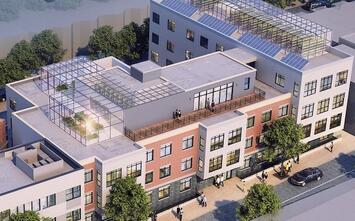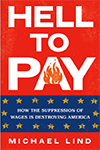
The Washington Post has discovered that there are “inefficiencies” in the nation’s affordable housing programs, including its largest one, low-income housing tax credits. Due to these inefficiencies, one non-profit developer in DC is spending up to $1.3 million per housing unit. Another developer spent $800,000 per unit, while right next door the very same developer built market-rate housing for just $350,000 per unit.
Ontario Place, the project pictured above, “will include a rooftop aquaponics farm to produce fresh fruits and vegetables for its tenants,” which contributed to the $1.2 million per unit cost. Another expensive project found by Post writers, which cost “only” $815,000 per unit, “includes a fitness room to encourage physical activity, a library, a large café with an outdoor terrace, a large multi-purpose community room with a separate outdoor terrace, an indoor bike room, on-site laundry, lounges and balconies on every floor.”
As economist Alex Tabarrok recently observed, affordable housing is unaffordable because the agencies distributing the funds are often more concerned about such things as environmental sustainability, racial equity goals, community development, and other factors that have little or nothing to do with affordable housing. Due to these misplaced priorities, I calculated more than a year ago, between 2004 and 2019, the amount of money spent subsidizing affordable housing more than doubled but the number of units built declined so that the subsidies per unit increased by at least 130 percent.
Most affordable housing projects are supported by multiple federal, state, and local housing funds. A report from California found that each additional funder adds more than $20,000 per unit to total development costs.
The Post discovered that New Jersey has set a cap of under $400,000 per affordable housing unit. “When you look at a deal structure, almost everyone else in the deal makes more money when costs go up,” the director of New Jersey’s housing agency told the Post. The developers themselves typically get 15 percent as a “developer fee.” So neither the developers nor any of the contractors have an incentive to oppose policies that make either affordable or market-rate housing more expensive.
Most developers sell low-income housing tax credits to banks for 25 percent discounts. The developers themselves have been found to get 45 percent of the benefits from affordable housing projects. After deducting costs added to the projects in the name of sustainability and other goals, low-income people probably get less than 20 percent of the benefits of the projects.
Congress created low-income housing tax credits in 1987 in the hope that private developers would be more efficient in building affordable housing than public housing agencies. Instead, the program has proven that private businesses can be just as wasteful and costly as public agencies if they are given the same bad incentives. It’s time to abolish affordable housing programs. If four-fifths of the benefits of affordable housing go to people other than tenants, low-income families would be better off if just one-fourth of the costs of those program were dedicated instead to housing vouchers.
This piece first appeared at The Antiplanner.
Randal O'Toole, the Antiplanner, is a policy analyst with nearly 50 years of experience reviewing transportation and land-use plans and the author of The Best-Laid Plans: How Government Planning Harms Your Quality of Life, Your Pocketbook, and Your Future.
Photo: Ontario Place, a so-called affordable housing project that is costing $1.2 million per unit. Courtesy the Antiplanner













Overpriced Low Income Housing
Randall, good to hear from you. I'm not going to mention names here. Many decades ago, when Detroit's economy was in a severe downturn, I saw a developer building new apartments and office towers. I was talking to a person who knew this individual well, and told him that I was not impressed that they were building the massive amount of development - what would impress me more if they actually leased all the space. This is what was the response: They said Rick, they cannot lose because they convince the bank it will take $20 million to build when it actually takes $10 million and maybe it takes $2 million up front to get the deal done. If it fails the bank is held with the mess and the $10 million profit is guaranteed. There is no way to lose on a deal like that. This is why you have new cities being built in China with no residents. More recently, another friend who is highly respected in Minneapolis the 'go-to' person for affordable apartments and townhomes recently had lunch with me. He said that to get State subsidies on low income he needed to hire Union labor and have material Union sourced which essentially doubled the cost per unit no doubt one of Tim Walz ideas. To offset all this cost the State would offer a 20 year no interest 'loan' as if that does not double the cost of housing. He said he thinks he's done building. Check out Esperanza Homes in McAllen Texas area. You get a beautiful new home on a large(ish) lot with high ceilings, parks, trails, amenities, landscaping, 2+ car garage, brick or stucco, on the lower $200's to $300K range. It would be far more advisable for lower income families to move to South Texas and have a wonderful place to live with plenty of employment opportunity, in my opinion. When I see projects that have $1.2 million low income units being built, I know there is funny money that we the tax payers ultimately will be paying for the fall out.